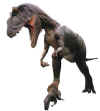You are on Dinosaur Fossils page 5
Click to go to: Page 1 Page 2 Page 3 Page 4Page 6Page 7 Page 8 Page 9
TABLE OF CONTENTS IS ON PAGE 1
Contents this page: Article "The Scoop on Poop" informational about Coprolite, Dinosaur coprolite SLICES
Just a sign created for us says it all! Just call us the Francis Ford Coprolite of the fossil industry!
|
HERE'S THE SCOOP ON THE POOP...
An article explaining this phenomenon |
|
"Coprolite" means "dung stone", from the Greek kopros (dung) and lithos (stone). Fossils occur in two forms: body fossils (bones, shells, teeth), and Trace fossils (footprints, burrows, coprolites). Studying the trace fossils helps us understand how animals behaved - what they ate, how they digested it, where they deposited it.
Feces are preserved by being in caves, or deposited outside which must be quickly covered by sediment under just the right conditions to preserve it, as it is a soft material (not like bones). Bacteria change the chemistry of feces, which help it absorb minerals that changes it to colorful stone over millions of years as it "lithifies". How do we know a rock is really poop? 1) Poop has more phosphorus than other rocks 2) it contains bits of bone, shell, wood or leaves, sometimes more! 3) It has dung beetle tracks or burrows as they worked through it 4) often the dinosaur skeletons are found nearby, or it is a known formation where fossils are found How do you decide what critter the poop is from? 1) The age of the rock in which it is found will limit which critter it could be 2) Are there fossil remains of creatures nearby? 3) Size and shape of the coprolite 4) compare the appearance and size of the coprolite to modern animals, if it is not extinct Can you give me some examples? Example 1: Coprolites were found in the Montana Badlands. They were full of plant material from redwood trees such as pine cones. They had dung beetle tracks & burrows in the specimens. The strata of the rock in which they were found dated to 75 million years ago. They were the size of basketballs. Maiasaura dinosaur fossils were nearby, an herbivorous duckbilled dinosaur. Therefore, it was concluded they were Maiasaura dinosaur coprolites. Example 2: In the 1990's, a man in Alberta, Canada found a two foot coprolite. It tested positive for high amounts of phosphorus, it contained chopped bits of organic matter. The rock strata dated it to 75 million years old. The size of it: 2 feet long, meant it was from a large animal. They also found chopped up bones in it, meaning it came from a carnivore (meat eating) animal. Based on what was found in the area, it is most likely the older smaller cousin of a T-Rex. The surprise? The found FOSSILIZED MUSCLE CELLS in the coprolite from undigested meat. What a find for these paleontologists! Example 3: The first coprolites identified. In the early 1820's, geologist William Buckland found bones of ancient hyenas, elephants and hippo. He also found white rocklike blobs about the size of a cherry. He went to the zoo and examined the feces of living hyenas - it matched! The shape, size and appearance were similar. Then he compared the minerals found in the blobs with those found in fresh feces, with the help of a fellow scientists, and he was correct! The minerals were similar to those found in the coprolites. Do you have more information? Find and read the young people's book: "Dino Dung", by Dr. Karen Chin or go on Amazon and type in "coprolite" for other great books to read! |

Brachiosaurus is on the move!
| INFORMATIONAL ONLY |
|
Look what our customer Johan Gustafsson in Sweden achieved inlaying a slice of our dinosaur coprolite in the handle of this beautiful collector fixed-blade knife:
And a folding knife inlaid with Fossilized Baltic amber: and another folding knife inlaid with a slice of fossilized woolly mammoth tooth: Truly works of art. Contact him if you're interested in more information: |
Click to go to: Page 1 Page 2 Page 3 Page 4Page 6Page 7 Page 8 Page 9
TABLE OF CONTENTS IS ON PAGE 1












